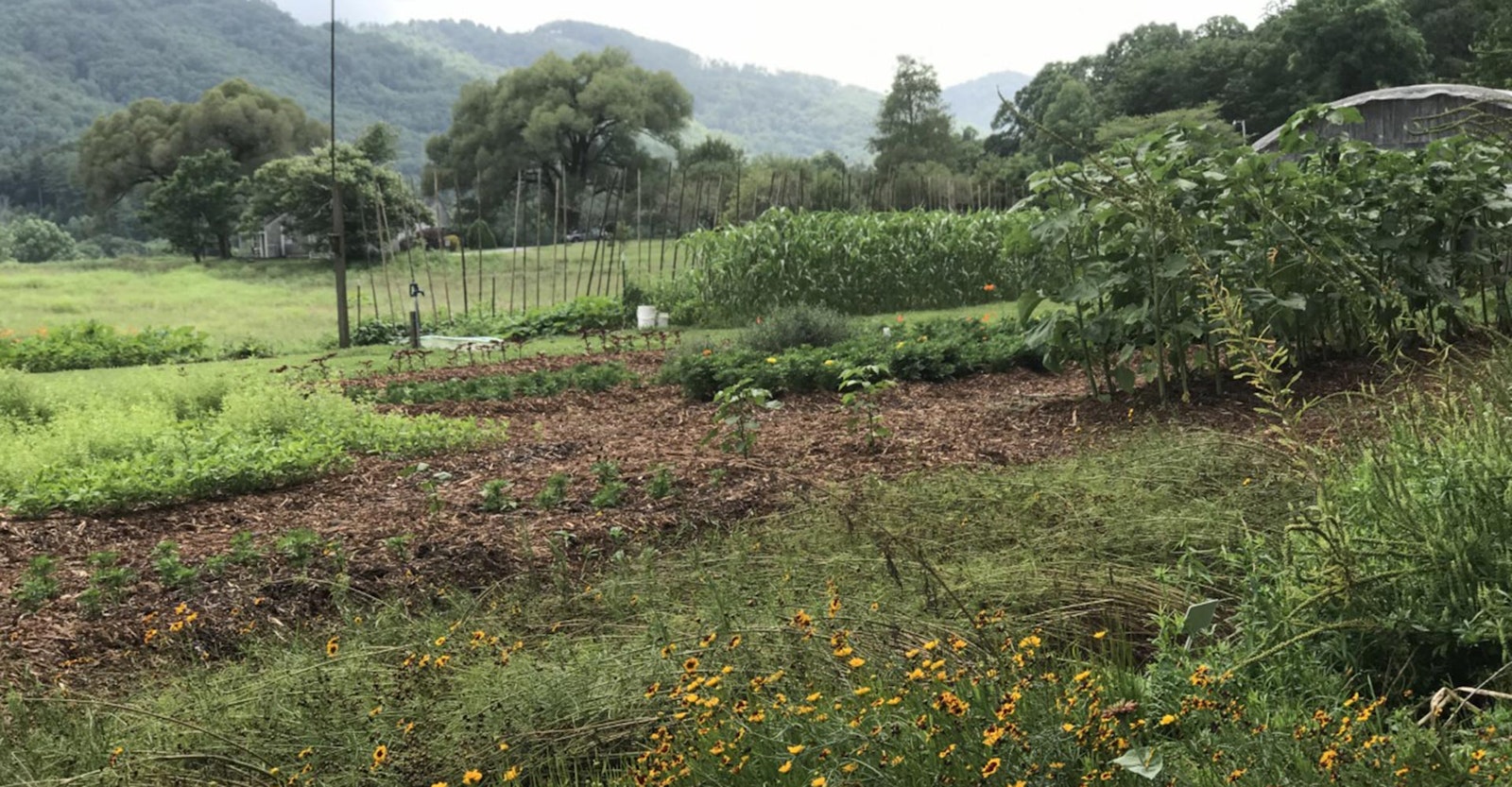Many of us who are inspired by natural and plant dyes have foraged or bought exotic dyestuffs from around the globe. But now at John C. Campbell in Brasstown, North Carolina, we will see what dye plants look like and use them fresh.
Donna and Cliff Brown generously endowed a dye garden to memorialize their beloved son, Cory. Folk School director Jerry Jackson says, “The dye garden will become an important part of the school's programming.” Donna Brown led the study group in preparation for the Janice Ford Memorial Dye Garden, which was established in 2015 in conjunction with the Denver Botanic Gardens, and remains an active member there. She plans to return to the Folk School in Spring 2022 to offer classes in deriving pigments and paints from plant dyes.

Preparing for a new season in the Cory Brown Memorial Dye Garden.
Looking Back and Looking Forward: Natural Dyes and the John C. Campbell Folk School
In my time, since 1978, I have been mostly an opportunistic natural dyer. I know the color-bearing plants and pick them when they are ready and available. When I started, the gossip was that the natural dyers were going to clear the world of all vegetation! (That must have been a mutter from the chemical dye industry.) We found instructions in The Dye-Pot by Mary Frances Davidson, which she first self-published in 1950. In a foreword to the 1976 edition, Marion Heard wrote, “A new challenge was created for Mary Frances Davidson that day long ago when she visited the John C. Campbell Folk School and was introduced to the beauty of vegetable dyed yarns. She was so stimulated that she immediately began to investigate all available sources of knowledge.” It reads like your Granny’s recipe book, and Mary Frances tried many, many plants.
Mary Frances must have met Louise Pitman, who came to the school in 1928 and specialized in natural dyeing. In “Vegetable Dyes,” an article in the 1938 Bulletin of the Garden Club of America, Louise wrote, “The buzz of the locusts heralds a hot July day for this corner of North Carolina’s mountains, but the heart of the dyer is eager . . . [T]here is still place for natural dyes: dyes which reflect nature in its quiet gradations of fields, mountain slopes, and sky.” Louise’s index cards, which record her handwritten vegetable dye formulas and notes along with samples, are all still in the archives of the John C. Campbell Folk School.
One of Louise Pitman's handwritten dye recipe cards, this one for madder and logwood.
The legacy of natural dyeing at the Folk School continued from hand to hand. Jim Liles, who started dyeing with Mary Frances, made many informational transformational discoveries that became his book The Art and Craft of Natural Dyeing: Traditional Recipes for Modern Use. Carol Leigh Brack Kaiser, author of Nature Provides Dyes for Rainbows, learned with Jim.
Stretching further back, who else talked about growing color in the southern mountains? In Mountain Homespun (1931), Frances Goodrich wrote, “Another favorite dye for coverlets was madder. This also could be bought, but if raised in the garden and used fresh it was much brighter . . .” Based near Asheville, Goodrich was part of the craft revival movement and a founding member of the Southern Highland Craft Guild, of which Folk School founder Olive Campbell was also a founding member.

A basket of wool dyed with plants from the new garden, tucked in a handmade white oak basket by Peggy Patrick. The Folk School offers classes in dyeing and basketry.
With our traditions and dedication to natural dyeing, we had to make a dye garden, tucked into the heart of the John C. Campbell Folk School campus. It's what we can add to the renewed natural dye landscape. For the first time in my memory, dye gardens are popping up, helping those who have never pulled color from a pot to understand the link between plants and color.
The garden increases the possibilies for of garden-based classes in a variety of subjects from printing, painting, photography, and dyeing to cultivating plants for basketmaking and even beekeeping. Class offerings are listed on the John C. Campbell Folk School website.
Martha Owen is a resident artist in spinning, knitting, feltmaking, dyeing, and surface design at the John C. Campbell Folk School in Brasstown, North Carolina. Her adventure in spinning and natural dyeing began at this very school in 1978. Since 1980, Martha’s extended family has included sheep, Angora rabbits, and Great Pyrenees and border collies. Also a banjo player and storyteller, Martha’s interest in sheep, wool, music, and dance has carried her joyfully around the world. Her children say she is a wool nerd, but her sheep say she is outstanding in her field! Learn more at folkschool.org and on Instagram @marthaowenwoolens.

